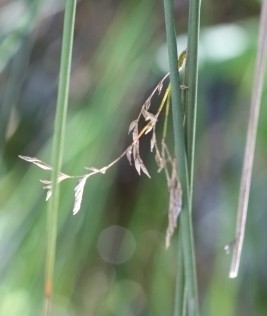Basket rush
(Juncus textilis)

Description
Juncus textilis is a species of rush known by the common name basket rush. It is endemic to California, where it grows along the coast and in the coastal mountain ranges of the southern half of the state. Juncus textilis is a rhizomatous perennial herb growing to a maximum height between 1–2 metres (3.3–6.6 ft). The stems are cylindrical with faint longitudinal grooves. The leaves lack blades and appear as small brown sheaths around the base of the stems. The long, bushy inflorescence arises from the side of the stem and splits into long branches bearing clusters of many flowers. Each flower is cupped by small, clear bractlets and has pointed greenish brown tepals. There are six stamens with large anthers. The fruit is a dark brown, shiny capsule. This species of rush has been used historically for basket weaving by several Native American peoples of southern California, such as the Cahuilla, Kumeyaay, and Chumash, among others. Juncus textilis is an important plant endemic to California; Chumash people use it today for basket-making as they have been for centuries. Juncus is a genus of monocotyledonous flowering plants, commonly known as rushes. It is the largest genus in the family Juncaceae, containing around 300 species. Rushes of the genus Juncus are herbaceous plants that superficially resemble grasses or sedges. They have historically received little attention from botanists; in his 1819 monograph, James Ebenezer Bicheno described the genus as "obscure and uninviting". The form of the flower differentiates rushes from grasses or sedges. The flowers of Juncus comprise five whorls of floral parts: three sepals, three petals (or, taken together, six tepals), two to six stamens (in two whorls) and a stigma with three lobes. The stems are round in cross-section, unlike those of sedges, which are typically somewhat triangular in cross-section. In Juncus section Juncotypus (formerly called Juncus subg. Genuini), which contains some of the most widespread and familiar species, the leaves are reduced to sheaths around the base of the stem and the bract subtending the inflorescence closely resembles a continuation of the stem, giving the appearance that the inflorescence is lateral. Juncus has a cosmopolitan distribution, with species found throughout the world, with the exception of Antarctica. They typically grow in cold or wet habitats, and in the tropics, are most common in montane environments.
Taxonomic tree:







